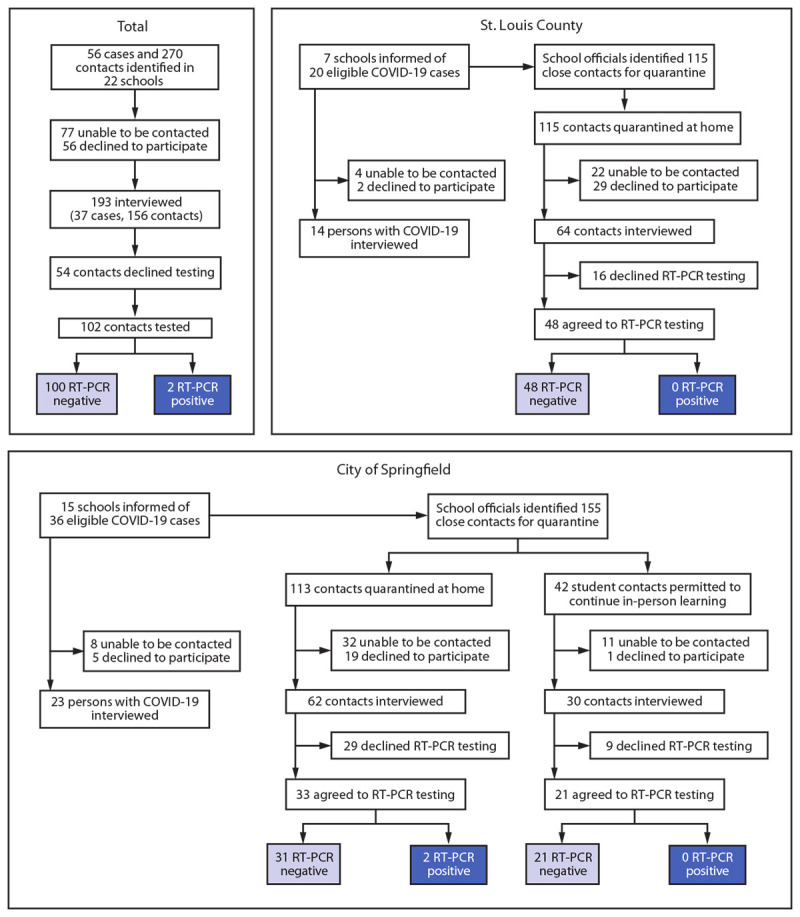FIGURE.

Identification of students, teachers, and staff members with school-associated COVID-19,* school-based close contacts,† and SARS-CoV-2 RT-PCR test results§ among close contacts — St. Louis County and city of Springfield, Missouri,¶,** December 2020
Abbreviations: K–12 = kindergarten through grade 12; NAAT = nucleic acid amplification test; RT-PCR = reverse transcription–polymerase chain reaction.
* Receipt of a positive NAAT or antigen test result in a student, teacher, or staff member who was physically present at the school or a school-associated event while potentially infectious; cases were most often reported to school officials within 1–2 days of laboratory results.
† Any person who spent a cumulative total of ≥15 minutes in one 24-hour period within 6 ft of a person with COVID-19 while that person was potentially infectious, regardless of mask use. A person with COVID-19 was considered potentially infectious to others starting from 2 days before symptom onset (or if asymptomatic, 2 days before the collection of their first positive SARS-CoV-2 test specimen) until the person was isolated. https://www.cdc.gov/coronavirus/2019-ncov/php/contact-tracing/contact-tracing-plan/appendix.html#contact
§ Among 168 contacts who did not receive testing from the investigation team, during the 14 days after their last exposure, no other school-associated cases with a positive SARS-CoV-2 NAAT or antigen test result were reported to school officials.
¶ In November 2020, Springfield–Greene County Health Department and Springfield Public Schools adopted a modified quarantine policy for K–12 schools. Under this policy, student close contacts of a person with COVID-19 were permitted to attend school in person during their quarantine period if 1) the school had a mask mandate, the school’s classrooms were arranged to maximize physical distancing, the school had increased hand hygiene practices, and the school screened students and staff members for COVID-19 symptoms and immediately isolated symptomatic persons and 2) the close contacts were K–12 students aged ≤18 years, their only exposure to the person with COVID-19 was in the educational environment (e.g., a classroom), they did not have prolonged (≥15 minutes) direct physical contact with the person with COVID-19, and the close contacts and person with COVID-19 had all been wearing masks appropriately during the time of exposure. https://www.springfieldmo.gov/5369/Modified-Quarantine
** The two close contacts who received positive SARS-CoV-2 RT-PCR test results were from separate Springfield schools, were quarantining at home, and were contacts of two different persons with COVID-19 (persons A and B). School-based secondary transmission was probable for both contacts based on their exposure histories and symptom and testing timelines. One student contact of person A (a student in the same grade) received a positive test result 6 days after exposure. Although no genetic sequencing data were available, the student had no other known sources of exposure. One student contact of person B (a teacher) received a positive SARS-CoV-2 test result 7 days after exposure. The student was exposed in the classroom (<3 ft from the teacher for >15 minutes) and had no other known exposure sources. The consensus sequence generated from whole genome sequencing of the student’s saliva sample was nearly identical to that of person B, differing by only one nucleotide.
